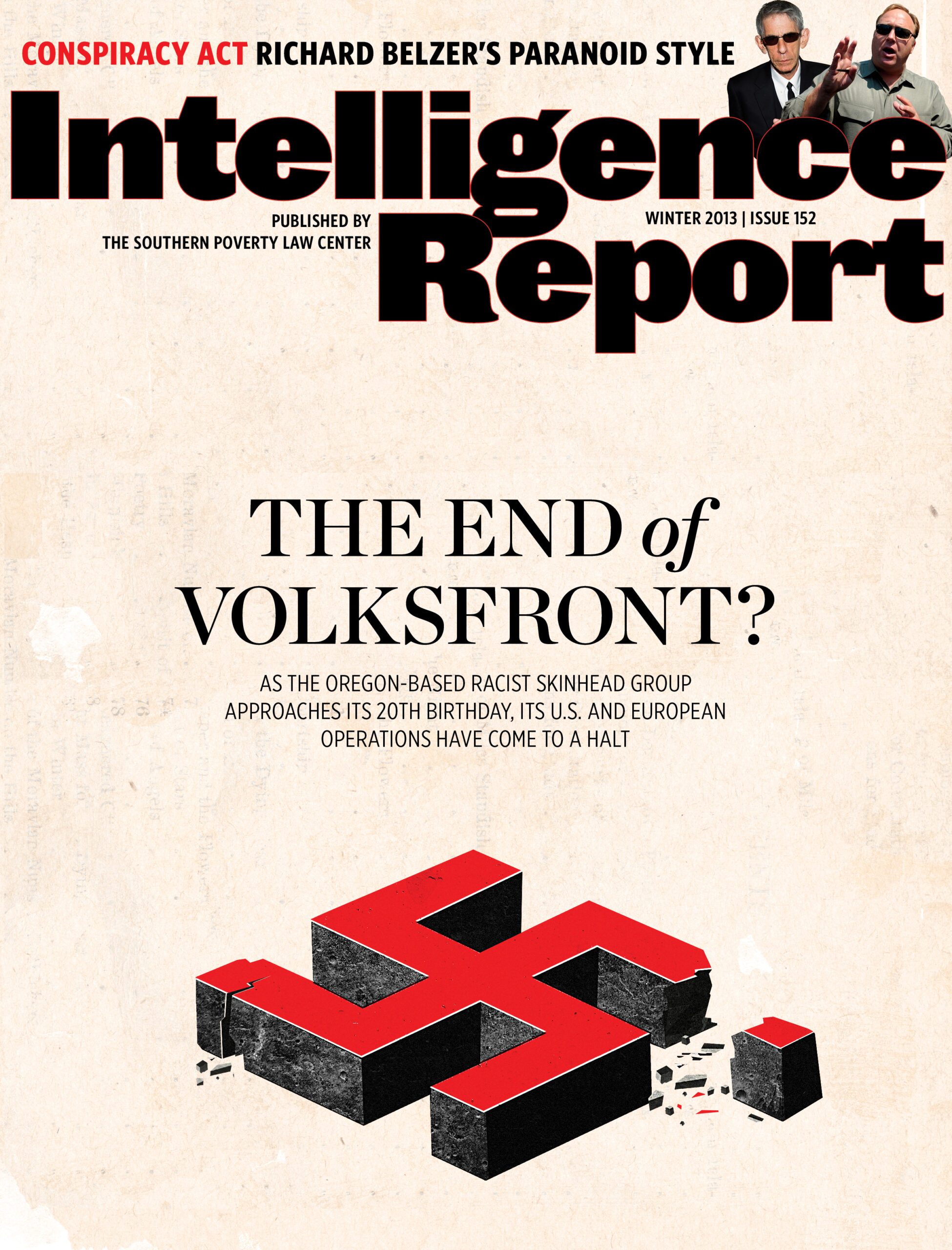Volksfront, once a powerhouse neo-Nazi skinhead group, appears to have collapsed. So have most of the other once-important groups on the radical right. Still, hate groups continue to present a serious threat and their numbers remain at record levels.
Is this really the end of Volksfront?
That’s the question we pose with this issue’s cover story, which takes a look at one of the most violent neo-Nazi skinhead groups in the country and one with a global network of affiliates in at least two other continents.
The group, formed nearly 20 years ago in Portland, Ore., shut down all 17 U.S. chapters last year and founder Randal Krager retired. Now, as we report here, Volksfront’s European and Australian chapters may have crashed as well as a consequence of our exposure of their personnel and operations.
Our question is impossible to answer as yet. As we went to press, the overseas chapters had gone silent, essentially disappearing from the Internet and public activism, after we contacted key players about their activities.
What’s certain is that Volksfront’s troubles are symptomatic.
In the last dozen years, many of the country’s leading neo-Nazi organizations have essentially collapsed. The World Church of the Creator was largely destroyed when its leader went to federal prison for soliciting the murder of a federal judge. The Aryan Nations went belly up after a damaging Southern Poverty Law Center lawsuit and the death of its founder. And now, as we detail in this issue, the National Alliance, once the most important hate group in America, is nearly dead.
Softer-line white nationalist groups are not exactly thriving either. The Council of Conservative Citizens, a once relatively influential descendant of the segregationist White Citizens Councils of the 1950s and 1960s, has begun to atrophy as its leader, Gordon Lee Baum, grows old. The neo-secessionist League of the South, which in recent years began speaking of armed resistance, has gotten so far out that its leader, Michael Hill, recently tried to dial back its vitriol.
Even American Renaissance, an anti-black organization led by the still-energetic Jared Taylor, seems to be waning in importance and regularly sees its events denied meeting venues thanks to anti-racist agitation.
Who’s left of any importance on the racist scene?
It’s not the most impressive lineup. There’s Jeff Schoep, whose National Socialist Movement is currently the largest neo-Nazi formation in the country. Schoep is known for leaving his wife after she developed breast cancer for a younger woman, burglarizing a home while one of his children was left waiting in a getaway car, and dressing up in ridiculous Nazi and, more recently, Italian fascist outfits.
There’s Craig Cobb, the raving mad neo-Nazi who’s taken on the near-hopeless task, detailed in this issue, of trying to turn tiny Leith, N.D., into an all-white homeland — a town he wants to rename Cobbsville.
There are a batch of Klan groups, typified by the United Klans of America (UKA), now trying to convince the world that they are actually anti-racist organizations. The UKA even met with the NAACP to make that dubious point.
And there is Crew 41, a neo-Nazi skinhead group like Volksfront that is also described in this issue. The tiny organization was virtually unknown until this summer, when its leader allegedly kicked in the skull of a man in Kearney, Neb., and two South Carolina members told police they murdered a man and his wife because the man was a registered sex offender. It turns out that the leader of the group’s Colorado chapter was the very same thing.
Mike Lawrence, a top leader of Volksfront, exemplified what many racists are feeling. Renouncing his group recently, he charged that “the so-called ‘movement’” is thick with “pedophiles, sociopaths, misfits and retards.”
None of this means that hate groups today aren’t dangerous.
First of all, there are more of them — along with the huge number of antigovernment “Patriot” groups that have sprung up since Barack Obama became our first black president. Second, the lack of strong group leaders often fosters, rather than retards, violence from “lone wolf” attackers. And, third, the fact that the organizations are weak does not mean their ideas are not spreading. After all, the forces driving them, most importantly changing demographics, still exist.
That can be seen in several cases mentioned in this issue. Radical propaganda clearly influenced Tamarlan Tsarnaev, the alleged Boston Marathon bomber killed in a confrontation with police; Frank Taafe, the self-appointed defender of the killer of Trayvon Martin; and even Richard Belzer, the TV actor who plays Detective John Munch and has become an antigovernment conspiracy theorist of late.
Violence from the radical right, in fact, seems to be growing, even as the foreign and domestic jihadist threats diminish — facts attested to in numerous expert studies summarized in the pages that follow. One such study even claims the 2000s experienced levels of far-right violence four times higher than the 1990s.
Our country still faces major challenges as it transitions to a nation not dominated by any single racial group over the next 30 years. Right-wing terror is very much alive and we certainly could face another Oklahoma City bombing. But the organized radical right, for all the very real threats it poses, does seem to be weakening, at least for the time being, and in the end that will be a good thing for all of us.



